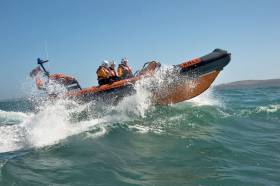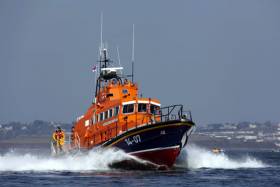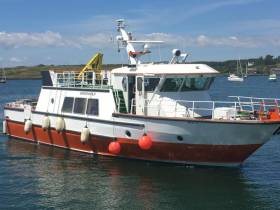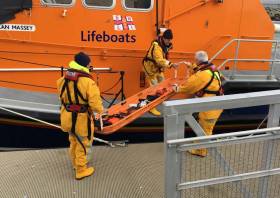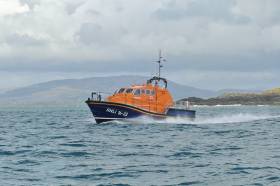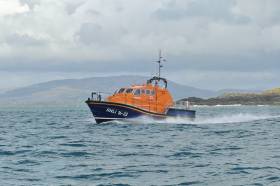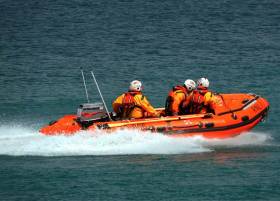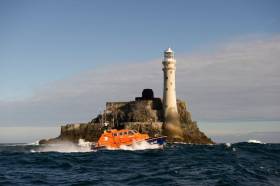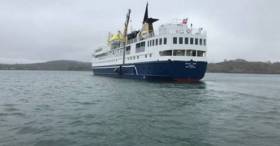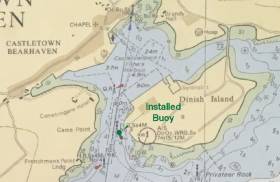Displaying items by tag: west cork
Baltimore Lifeboat Launches To Speedboat With Engine Troubles
#RNLI - Baltimore RNLI was called out last night (Tuesday 4 September) to a speedboat with engine trouble near Bird Island in West Cork.
The volunteer lifeboat crew were on exercise in their inshore lifeboat when the request came in from the Irish Coast Guard at 7.55pm to assist the 17ft speedboat, with four people onboard and reporting to have engine trouble north of the island near Cape Clear.
The lifeboat, with three volunteer crew onboard — helm John Kearney, John McDonough and Colin Rochford — was already in the vicinity of Cape Clear when the call came in and reached the casualty vessel at 7.57pm.
Conditions at the time were calm with a northerly Force 2-3 wind and slight sea swell.
When the lifeboat crew arrived on scene, the speedboat was only 100m north of Bird Island and was drifting towards the shore in calm seas, but in an area known for its strong tides.
The lifeboat immediately secured a tow line to the bow of the speedboat and, after confirming all onboard were okay, they towed the vessel to Baltimore harbour.
In other news, Baltimore RNLI’s annual barbecue will be hosted by Derry and Sally Anne Clarke at Sherkin House on Sherkin Island from 1pm this Saturday 8 September. All are welcome and no booking is required.
#RNLI - Courtmacsherry RNLI’s all-weather lifeboat Frederick Storey Cockburn was called out at 9pm on Friday night (3 August) to go to the aid of a 36ft yacht adrift some 18 miles off the Old Head of Kinsale in West Cork.
Under coxswain Sean O’Farrell and a crew of six, the lifeboat was underway within minutes, travelling at its top speed of 25 knots, and located the vessel at 10.30pm.
The yacht had been on passage from the Isle of Wight when it lost power and its crew sent out a distress message to the Irish Coast Guard.
The lifeboat immediately attached a tow rope to the casualty and proceeded to tow the yacht, which had four crew onboard, slowly and safely back to Courtmacsherry Harbour.
Friday night’s callout was the first to use the Courtmacsherry station’s early warning message Siren, which will now be part of every callout in order to alert people in the water nearby or the public in the village that a lifeboat call is in progress.
Lifeboat operations manager Brian O’Dwyer said: “It’s been the busiest six weeks for many a year and many thanks to all the volunteers at the station for always putting the rescue of others ahead of all their other interests.”
The busy time continued over the August Bank Holiday weekend as the Courtmacsherry lifeboat was called at 12.20pm n Saturday afternoon (4 August) to a pleasure cruiser in difficulty off the Seven Heads peninsula.
The casualty boat, with three on board, had fouled its propellers and lost power while on passage to Castletownshend, having departed Crosshaven the previous day.
Once again under coxswain Sean O’Farrell, the lifeboat towed the stricken vessel back to the safe surrounds of the Courtmacsherry Pier Pontoon.
#FerryNews - A new fast ferry has just been commissioned for Cape Clear Island Ferries after completing various surveys and sea trials and a number of modifications to comply with Irish MSO standards.
Dún na Séad II was purchased in Norway earlier this year and arrived in Baltimore in April. It is capable of speeds of up to 20 knots with an operating speed of 18 knots and has a crane and cargo capacity of 6 tons.
Features include airline-style seating with large windows in a comfortable saloon with air conditioning and other features.
Licensed for 97 passengers with upper deck seating that affords outstanding 360-degree views of Roaringwater Bay, the ferry marks a substantial investment for the Cape Clear Island Ferries which owns three other passenger vessels: Dún an Óir II, Dún Aengus and Cailín Óir.
Dún na Séad II will operate primarily on the Schull—Cape Clear route but it is planned to use her occasionally on the Baltimore—Cape Clear route which is the main year-round service to the island.
Current traveling times of 45 minutes from both Schull and Baltimore will be halved when this vessel is in use.
Cape Clear Island Ferries says that the larger vessel together with the shorter journey time more than doubles the potential passenger capacity, and its focus will be on larger groups, bus and coach tours as well as building relationships with complementary service providers.
The ferry company has in recent years focused on soft adventure tourism surrounding the Fastnet Rock Lighthouse, which has shown double-digit growth over the past four years.
Considered the ‘Gateway to the Fastnet’, Cape Clear Island regularly welcomes passengers arriving from both Schull and Baltimore to see the famous rock.
While the company does not offer specific whale-watching trips, whale and dolphin sightings are a frequent occurrence in the area.
Cape Clear Ferries is owned by local shareholders on Cape Clear Island and Baltimore and its management, shareholders and staff are all from the immediate area. The business was established in 2007.
Baltimore Lifeboat In Medevac From Cape Clear Island
#RNLI - Baltimore RNLI carried out a medical evacuation yesterday afternoon (Wednesday 25 July) from Cape Clear Island off the coast of West Cork.
The volunteer lifeboat crew launched their all-weather lifeboat following a request from the Irish Coast Guard at 1.42pm to provide medical assistance and evacuation to an islander living on Cape Clear.
Arrived in North Harbour at Cape Clear at 2.05pm, four of the volunteer crew went to the casualty’s location to assist with transfer and casualty care.
Once ready, the casualty was brought onboard Baltimore lifeboat and they departed the island at 3.07pm. The lifeboat returned to station in Baltimore and handed the casualty over to the care of HSE ambulance crew at 3.51pm.
Conditions at sea during the call out were relatively calm, with a south-westerly Force 3-4 wind and one-metre sea swell.
Speaking after the callout, Baltimore RNLI volunteer lifeboat press officer Kate Callanan said: ‘Medical evacuations — medevacs — are a regular service that Baltimore RNLI provide between the mainland and islands, and also between the mainland and private and commercial boats at sea.
“If you find yourself in need of medical assistance, call 999 or 112 and ask for the coastguard.”
There were six volunteer crew onboard the lifeboat: coxswain Aidan Bushe, mechanic Cathal Cottrell and crew members Eoin Ryan, Kieran Collins, Emma Lupton and Don O’Donovan.
Baltimore Lifeboat In Two Friday Callouts To People In Difficulty On Passenger Vessels
#RNLI - Baltimore RNLI has praised the swift actions of one of its volunteer crew members in the rescue a man taken ill on a passenger vessel in West Cork yesterday afternoon (Friday 25 May).
In the first of two callouts yesterday, the all-weather lifeboat was requested to launch at 12.50pm following a report of man in difficulty on a small passenger vessel west of The Stags.
Weather conditions at the time were described as slightly choppy with a Force 3 easterly wind.
The skipper of the passenger vessel, a long-serving volunteer crew member with Baltimore RNLI, had immediately administered casualty care to the man when he started to show signs of being in difficulty, and the man was already in the recovery position as the lifeboat arrived minutes later.
Once on scene, the casualty was transferred onto the lifeboat where the crew continued to administer casualty care as he was brought back to Baltimore.
The man was then transferred into the care of paramedics and a waiting ambulance before he was brought to hospital for further treatment. Volunteer crew member Sean McCarthy provided assistance at Baltimore Lifeboat Station.
“All at Baltimore RNLI would like to wish this man a full and speedy recovery following his ordeal,” said Tom Bushe, Baltimore RNLI lifeboat operations manager.
“[The callout was] a fine example of how the RNLI’s lifesaving training can make a real difference and I would particularly like to praise the efforts of Micheal Cottrell, skipper of the small passenger vessel, who used his skills as a crew member to help bring this man to safety before the lifeboat arrived on scene.”
Baltimore RNLI has been called out for a second time today (Friday 25 May) to a separate incident to a woman who got into difficulty on a passenger vessel in West Cork.
Later in the afternoon, the volunteer lifeboat crew launched their all-weather lifeboat at 4.25pm following a request to provide a medevac for the woman about one mile southwest of the Kedge.
The casualty was transferred immediately to the lifeboat when it arrived on scene 10 minutes after launch. Casualty care was administered by the crew while the lifeboat made its way back to Baltimore lifeboat station.
Once at the station, casualty care was continued by the lifeboat crew until the HSE ambulance, a local GP and the Irish Coast Guard helicopter from Waterford, Rescue 117, arrived and took over care.
#RNLI - Baltimore RNLI carried out a medevac yesterday morning (Monday 21 May) from Cape Clear Island off the coast of West Cork.
The volunteer lifeboat crew were asked to launch their all-weather lifeboat following a request from the Irish Coast Guard at 7.53am to provide medical assistance and evacuation to a man living on the island.
The all-weather lifeboat arrived in Cape Clear at 8.25am and the casualty was transferred to the care of the volunteer crew onboard.
The lifeboat then returned to Baltimore lifeboat station at 8.55am and handed the casualty over to the care of HSE ambulance crew once they arrived at the station.
Conditions at sea during the shout were flat calm with a north-easterly Force 3 wind.
There were seven volunteer crew onboard the lifeboat: coxswain Aidan Bushe, mechanic Cathal Cottrell and crew members Brendan Cottrell, Micheal Cottrell, Jerry Smith, Emma Lupton and Don O’Donovan. Kieran Cotter provided shore crew assistance at the lifeboat house.
Speaking following the callout, Baltimore RNLI volunteer lifeboat press officer Kate Callanan said: “Baltimore lifeboat regularly provides medical assistance and transfers for people living, working or holidaying on the islands.
“This call is the third medical evacuation for Baltimore RNLI in the past two weeks.
“Always remember, if you find yourself at sea or on an island in need of medical assistance, call 999 or 112 and ask for the coastguard.”
RNLI Lifeboats In Medevac Shouts At Baltimore & Wicklow
#RNLI - Baltimore RNLI carried out a medevac on Saturday night (12 May) from Cape Clear Island off the coast of West Cork.
The volunteer crew were requested to launch their all-weather lifeboat by the Irish Coast Guard at 8.05pm to provide medical assistance and evacuation to a man working on the island.
Arriving in Cape Clear at 8.24pm, the RNLI volunteers transferred the casualty onto the lifeboat and returned him to Baltimore lifeboat station, whee he was handed over to the care of a waiting HSE ambulance crew.
Conditions at sea during the shout were calm with a south-westerly Force 3 wind and half-metre sea swell.
“So far this year medical evacuations make up a high percentage of the call outs for Baltimore lifeboat,” said Kate Callanan, Baltimore RNLI volunteer lifeboat press officer.
“Acting as an ambulance between the islands off the coast of West Cork is a vital service and our volunteer crews are trained to a high standard in first aid and casualty care.
“If you find yourself at sea or on an island in need of medical assistance, call 999 or 112 and ask for the coastguard.”
Hours later, Wicklow RNLI’s inshore lifeboat crew were alerted by pager shortly after 3.10pm yesterday afternoon (Sunday 13 May) to assist in the medic of an injured sailor in the town’s harbour.
The sailor was being treated on a yacht by first responders and HSC paramedics at the East pier after he sustained injuries while sailing in Wicklow Bay.
The lifeboat was requested to launch in case the casualty was seriously injured and needed to be evacuated from the yacht to a more suitable location for transfer to an ambulance.
The lifeboat, with helm Alan Goucher and crew Terry Sillery and Paul Sillery, was about to launch when lifeboat operations manager Des Davitt was made aware that the casualty was assisted up a ladder onto the pier after being treated by paramedics, and no further assistance was required.
#RNLI - Baltimore RNLI launched on Monday evening (7 May) to carry out a medical evacuation for a man from Sherkin Island off the West Cork coast.
The volunteer lifeboat crew arrived on scene at 7.40pm, just eight minute after launch, and provided casualty care before transferring the patient to the all-weather lifeboat and returning to Baltimore, where he was handed over to the HSE ambulance crew at 8.30pm.
Weather conditions were good at the time, with a south-westerly Force 2-3 wind and calm sea conditions within the harbour.
The volunteer crew onboard the lifeboat were coxswain Kieran Cotter, mechanic Cathal Cottrell and crew members Pat Collins, Aidan Bushe, Jerry Smith, Eoin Ryan, Don O’Donovan and Ronnie Carty.
Speaking following the callout, Baltimore RNLI volunteer lifeboat press officer Kate Callanan said: “The RNLI and other rescue agencies around the coast provide a vital service to those living or holidaying on islands. If you require assistance, please call 999 or 112 and ask for the coastguard.”
Cape Clear Port of Call A First By Cruise Ship
#CruiseLiners - For the first time ever a cruise ship called to the West Cork island of Cape Clear last Thursday morning with a group of 70 bird watchers.
Guests on the cruise ship Ocean Nova, writes the Evening Echo, were escorted by guides from Birdwatch Ireland who have a manned bird observatory on the island, and visited some of the island’s prime birdlife, wildlife, and marine life viewing spots.
While the main focus of the visit was birdwatching, they also took time to visit the island’s museum which depicts life on Cape Clear, past and present, and view its impressive exhibit about the building of the iconic Fastnet Rock.
Upon departure, the ship sailed around Fastnet and entered Schull Harbour, another first.
From there, coaches brought passengers to the Mizen Head Signal Station and Visitor Centre where they enjoyed not only the scenery, but observed the bird and marine life in this area.
To read more on the story, click here.
Buoy Change At Castletownbere Fishery Harbour Centre
#MarineNotice - Marine Notice No 13 of 2018 advises that the No 3 Green Perch at the entrance to Castletownbere Fishery Harbour Centre in West Cork has been removed due to damage.
The No 3 Green Perch has been replaced by a 1.5m green buoy in position 51° 38’ 49.387” North, 09° 54’ 27.41” West.
The light characteristic is a green flash every five seconds. This buoy will remain in position until further notice.
For safety reasons, mariners are requested to proceed slowly and with caution when in the vicinity of the green buoy.
For further information, contact the Castletownbere Harbourmaster’s Office at +353 27 70220.



























